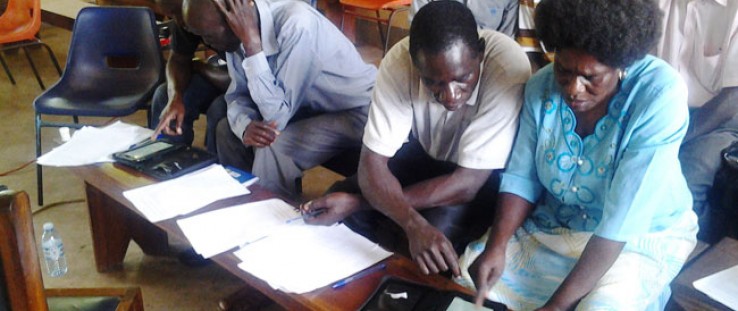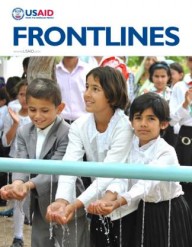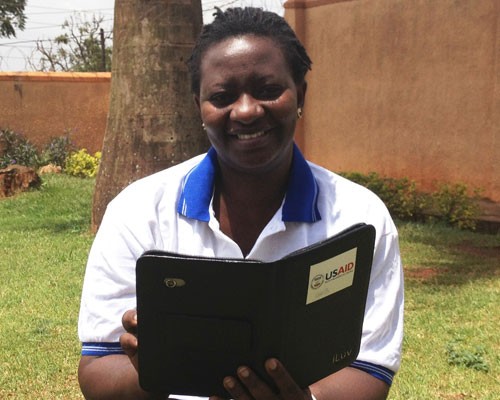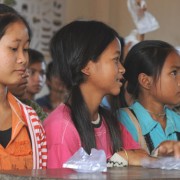 A Yumbe survey team learns how to use electronic tablets to collect data on trachoma.
Christine Ninsiima
A Yumbe survey team learns how to use electronic tablets to collect data on trachoma.
Christine Ninsiima
 A Yumbe survey team learns how to use electronic tablets to collect data on trachoma.
Christine Ninsiima
A Yumbe survey team learns how to use electronic tablets to collect data on trachoma.
Christine Ninsiima
On a hot day during the Uganda dry season, Christine Ninsiima walks along a dirt path to a remote household where she’s looking for trachoma in a small, rural village in Yumbe district. A team member for the Uganda Ministry of Health trachoma program, she has been doing this type of work for seven years. Trachoma is a blinding eye disease caused by an infectious bacterium.
“It is often hard work, involving long hours of collecting data in the field. With an average of 20 parishes per district, we visit two villages per parish and 35 randomly selected households per village,” says Ninsiima. “Generally, African households are often very big, so we stay busy interviewing each member of the selected family. After collecting thousands of questionnaires from each district, we have to enter the data one by one into a database to analyze the data. This process can often take weeks or even months after the data has been collected.”
Ninsiima is a member of one of five teams collecting prevalence data for trachoma, which is known to be endemic in 35 districts of Uganda. Efforts are underway to collect prevalence data in an additional six districts that are suspected to be endemic.
As of October 2012, Ninsiima and her colleagues have been armed with powerful new tools to improve data collection: Samsung Galaxy tablets, donated by USAID as part of its five-year ENVISION program that supports Uganda’s efforts to control and eliminate five endemic Neglected Tropical Diseases (NTDs)—lymphatic filariasis, schistosomiasis, trachoma, onchocerciasis and soil-transmitted helminthiasis. Implemented by RTI in October 2011, the program partners with CBM, Helen Keller International, IMA World Health, Sightsavers International, The Carter Center, Tulane University and World Vision.
When data collectors finish their tallies, the information is wirelessly transmitted to a central server accessible to Ministry of Health program managers and partners. Instead of taking months to compile and enter information from handwritten paper forms, the results populate an immediately downloadable database with the results summarized online.
Speed of diagnosis and treatment is particularly crucial for trachoma, a degenerative disease that is most commonly spread by direct contact with secretions from the eye and nose of affected individuals. If treated in the early stages with antibiotics, trachoma is easily cured without lasting effects. When left untreated, the symptoms may accelerate, often causing severe pain and blindness as a result of ulceration and scarring of the cornea. Surgery is often necessary in advanced stages of the disease.
“Mapping trachoma has become much more efficient with the mobile electronic tablets. The tablets have helped reduce not only costs, but also time—and the data collectors have really learned to adapt to the new method of data collection. Now results can be uploaded and analyzed immediately after collection,” says Ninsiima.
“A delay in receiving treatment may mean the difference between treating a minor eye infection and requiring corrective eyelid surgery,” says Dr. Patrick Turyaguma of the Ministry of Health trachoma program.
Uganda is unique in that, in comparison to neighboring countries, it has some of the highest rates of infection in the region. Geographically, about one-third of the country is known to be endemic. Approximately 253,000 people are already in need of surgery, and another 10.4 million people are living in endemic areas and at risk of contracting the disease.
The first real proof of the mobile tablets’ effectiveness in the battle against trachoma came in October 2012 when four districts were mapped, one of which, Adjumani district, had a high rate of the disease. The other three districts—Yumbe, Moyo and Pallisa—had infection rates lower than the threshold qualifying for mass treatment.
With quick data analysis made possible by the mobile tablets, the Uganda NTD Control Program had time to apply for additional quantities of the antibiotic, zithromax, used in treatment. As a result, people in the Adjumani district will receive antibiotics as part of the October 2013 mass drug distribution. Zithromax is donated by Pfizer Pharmaceuticals through the International Trachoma Initiative (ITI).
“The USAID-supported ENVISION project’s goal is to improve the health of the communities in Uganda by eliminating and controlling NTDs. This means a reduced disease burden on people in Uganda, and creating communities with healthier mothers and children,” says Dr. Ambrose Onapa, the RTI Uganda ENVISION program manager. “Reduced morbidity and blindness due to trachoma, for example, will enable people to be more productive and stronger contributors within their families and communities. This project is enabling people to reach their potential and focus on being productive instead of being burdened by diseases that can be prevented.”
Five NTDs, 20 Million People
In Uganda, the five targeted NTDs affect approximately 20 million people. As part of the ENVISION project, RTI International is working with the Ministry of Health and its partners to implement interventions to control and eliminate NTDs in 81 endemic districts in Uganda. As the NTDs overlap geographically, other disease programs may find areas of collaboration such as sharing data and training. Use of the electronic tablets, part of ENVISION’s successful pilot program, can assist other disease programs in mapping activities as well as in monitoring and evaluating data quality.
The touch-screen mobile tablets are a new technology for many of the personnel, who required training before use. The lack of wireless Internet facilities and access to a reliable power supply for recharging the tablets have been challenges to the users in the field.
“Some of the data collectors using the tablets are still learning, but they seem to become more efficient each time they use them. At first, it was difficult for them to type on the tablets, but now it has become much easier,” says Ninsiima.
Despite these challenges, the approach has caught the attention of Ministry of Health officials outside the national trachoma program. The Uganda NTD Control Program is now planning to use handheld devices for a number of upcoming surveys focused on data quality assurance, schistosomiasis (or snail fever) prevalence, lymphatic filariasis assessments and clinical reporting of NTDs. These activities will be supported by the Ministry of Health, ENVISION and other partners supporting NTD activities in Uganda.
The teams working under the Uganda NTD Control Program continually look for new, sustainable innovations that improve the efficiency and productivity of their work. Says Ninsiima, “We are really grateful for the innovations of the ENVISION project here in Uganda, and the mobile tablets are just one example of the success of introducing new technologies here.”
Phil Downs and Scott Torres are ENVISION technical advisers with RTI.













Comment
Make a general inquiry or suggest an improvement.